How to do keyword research for SEO?
-
Abdul Wadood
 This topic comes under chapter 6 in our SEO guide.
This topic comes under chapter 6 in our SEO guide.
SEO has changed a lot over the years. However, the fundamentals remain pretty much the same.
Keywords are one of the fundamental elements of SEO. When people enter a search query on Google, your blog should rank for it.
Keyword research will give you an idea of the keywords that people enter into the search engine.
But, how to do keyword research for SEO? In this guide, I’ve provided an in-depth explanation.
Let’s get started!
Table of content:
- What is keyword research?
- Why is keyword research important?
- Performing keyword research for SEO
- Long-tail keywords: What are they?
- Conclusion
Note: This guide to performing keyword research for SEO is pretty long. If you’re new to the SEO world, I recommend reading this complete guide, as it’ll be highly beneficial. However, if you came here to learn a specific topic, feel free to skip to the section you want to read.
What is keyword research?
Keyword research refers to finding out the terms that your target audience use in the search engine. It then involves optimizing your blog by including those phrases to make it rank higher in the search results.
Why is keyword research important?
Before discussing the importance of keyword research, I’ll quickly explain how search engines work.
Currently, there are more than 500 million blogs out of about 1.7 billion websites on the internet. Search engines perform three main functions to rank these blogs or websites on the Search Engine Results Page (SERP).
- Crawling: It refers to the process that search engines like Google use to gather information from websites.
- Indexing: Once the crawling process is completed, the search engine will store the crawled websites in its index. Once a page is indexed, it can rank in the Search Engine Results Page (SERP).
- Ranking: When a user performs a search, the search engine will go through the index and rank the website in the search results based on relevancy.
Nice!
Keyword research is the strategy that gives you insights into the search queries of users. These insights can help you frame your blog. Also, it lets you know what people are expecting from you.
When someone searches for a query in Google, your website should rank in the search results. Keyword optimization is one of the factors that influence the ranking of your website in search results.
However, the influence of keywords themselves in determining the ranking of your website has reduced compared to the early days. Nonetheless, including the right keywords in your content is essential for users to find your blog.
Performing keyword research for SEO
Performing keyword research isn’t a complicated task. You may find it difficult when doing it for the first time. However, as you gain experience, it’ll become pretty simple.
There are various tools out there to help you perform keyword research. Some of them include:
I have demonstrated to perform keyword research using SEMRush — one of the best keyword research tools.
SEMRush is an advanced SEO tool that comes loaded with several features. Most features of SEMRush are premium, which means you have to pay to use them without limitations. However, SEMRush does offer a free trial, which you can try before purchasing the software.
If you decide to use tools other than SEMRush, the method of performing keyword research will still remain pretty much the same.
Alright. Here’s how to perform keyword research for SEO.
Step #1: Prepare a list of seed keywords
The first step involved in keyword research is preparing a list of seed keywords. The seed keywords are short and contain one or two words or at most three words.
You should enter the seed keywords in keyword research tools to generate keyword ideas.
If you already know the topic of your blog, coming up with seed keywords is pretty easy.
For instance, if you’re about to write a blog on affiliate marketing, the seed keywords can be:
- Affiliate marketing
- Affiliate marketing strategies
- Affiliate marketing tips
Generally speaking, it’s pretty easy to come up with a list of seed keywords. But, if you’re finding it difficult, you can check your competitor’s website to get ideas.
You can also use Google autocomplete to find seed keywords.

Step #2: Enter the seed keywords in the tool
Once you prepare a list of seed keywords, you can enter it into your keyword research tool to get a huge list of keyword ideas.
For instance, I’ll enter the seed keyword “affiliate marketing” in SEMRush Keyword Overview tool.
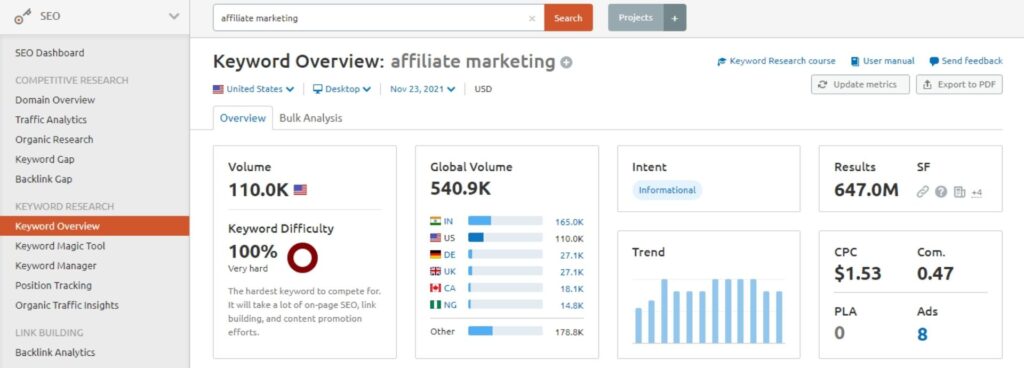
As you can see in the image, the seed keyword “affiliate marketing” has an average monthly search volume of about 110,000 in the United States. Similarly, the global average monthly search volume of the keyword is about 540,900. The keyword difficulty is 100%.
When you scroll down the page, you’ll be able to see the “Keyword Variations”, “Questions”, and “Related Keywords” sections. You can go through them to get keyword ideas.

Step #3: Analyze the data
Now that you have a massive list of keyword ideas, it’s time to analyze the data.
When analyzing the keywords data, here are the metrics you should note.
- Search volume
- Keyword difficulty
- Trend
- Search intent
1. Search volume
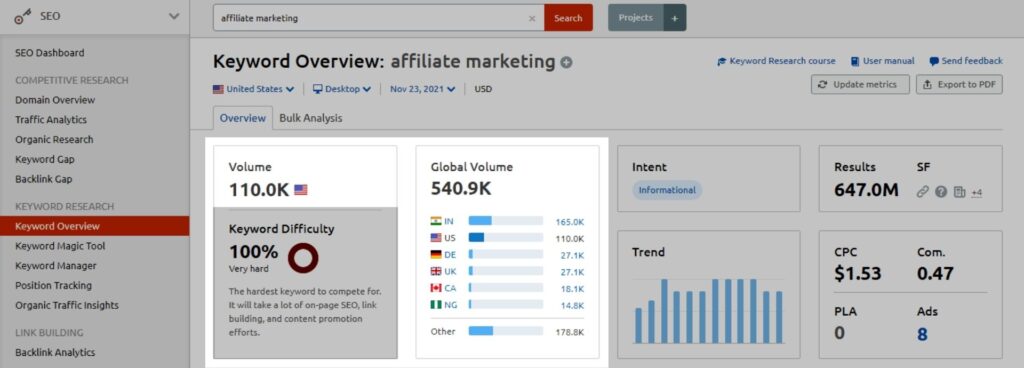
Search volume indicates how many times a specific search query is searched on Google per month.
The search volume shows the number of searches and not the number of people who searched. So, even if the same person searches on Google for something multiple times, it’ll increase the search volume. But, who does so, unless it’s a common query like what’s the time or weather.
If you’re performing keyword research to sell a product through your web page, you may also want to consider the highest contributing countries to the search volume. This is to make sure the people in your target country are searching for that keyword in Google.
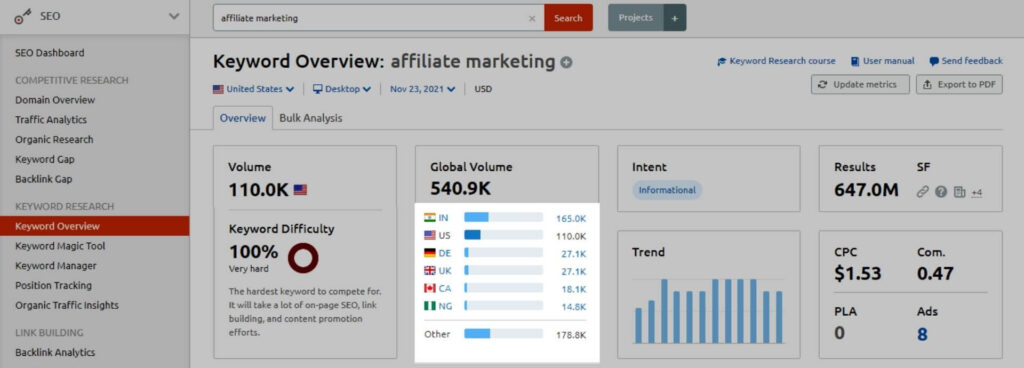
Now, you may think it’s better to opt for a keyword with a higher search volume as it’s likely to bring more traffic to your blog.
Well, you’re theoretically correct! But, there’s a catch!
In many cases, the keywords with a high search volume are highly competitive. If your website is new, it’ll be nearly impossible to rank high in the search results for a high search volume keyword.
So, you should look for keywords that have a decent search volume of about 1,000 to 10,000. Most keywords that fall in this category are long-tail keywords. Since long-tail keywords are more specific, it’ll bring targeted visitors to your blog.
I’ll explain more about long-tail keywords later in this guide.
2. Keyword difficulty
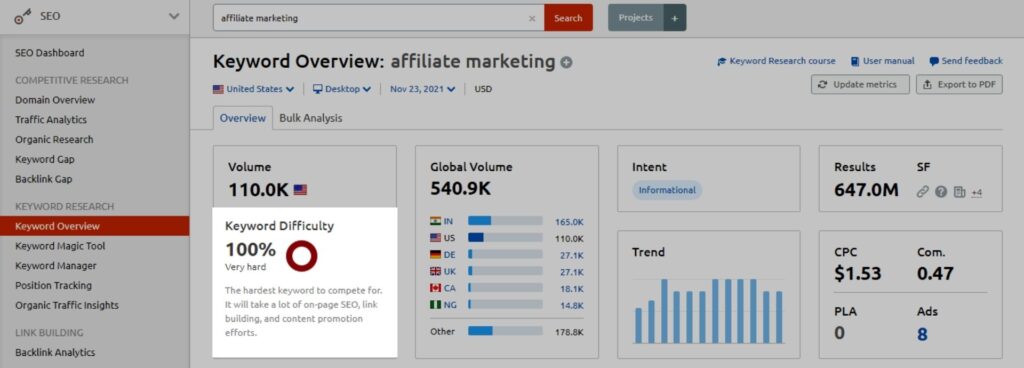
Keyword difficulty (or ranking difficulty) refers to how hard it’s to rank for a particular keyword.
Though keyword difficulty score can give you an idea of how difficult it’s to rank for a keyword, you shouldn’t solely depend on it. The ranking difficulty depends on a variety of factors such as:
- Content quality
- Domain authority
- Quality of backlinks
Keyword difficulty score ranges from 0-100. The higher the keyword difficulty score, the harder SEMRush predicts it’ll be to rank for it.
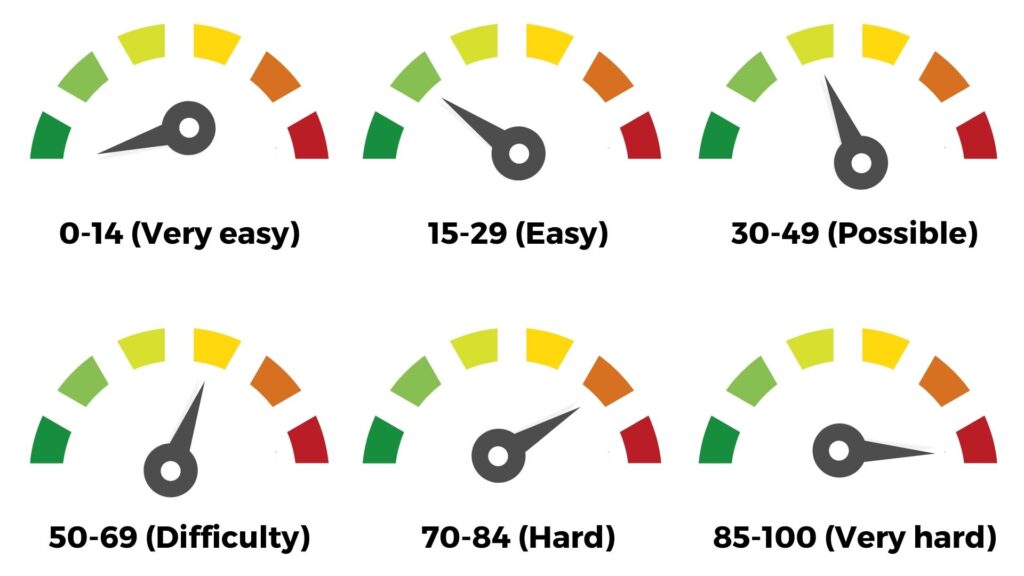
If your website is new, it’s better if you try ranking for keywords with a keyword difficulty score of less than 50. However, if your website has a high domain authority, you may also try ranking for keywords with a higher keyword difficulty score.
3. Trend
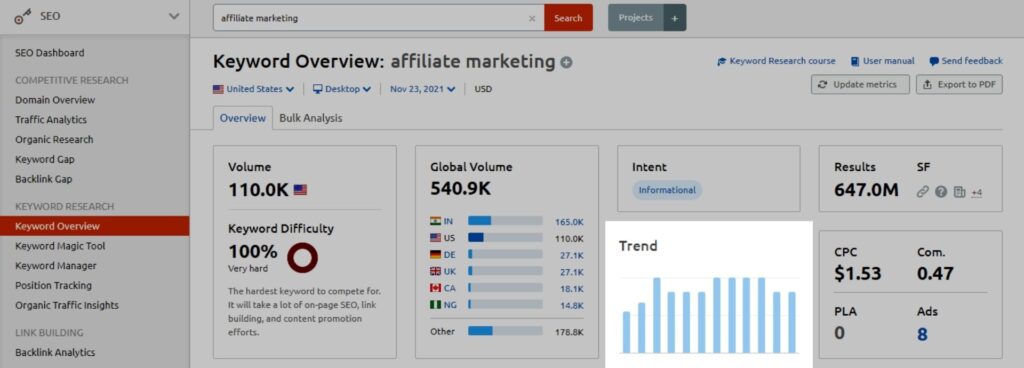
The trend indicates the interest that people showed over a keyword in the last 12 months.
When choosing a keyword, you should note whether it’s seasonal. If the keyword is seasonal, you’ll notice a sudden increase or decrease in the trend.
I suggest you stay away from seasonal keywords as they may not be able to give out the best results.
4. Search intent
Search intent shows the purpose of a user’s query in Google. Search intent is otherwise known as user intent.
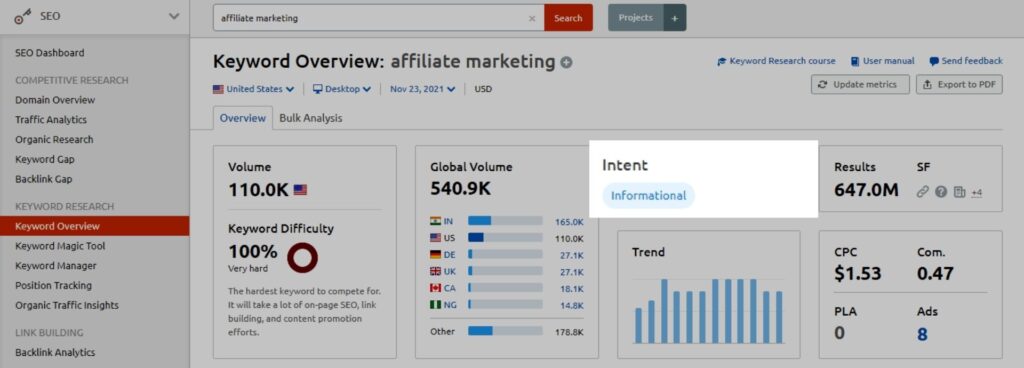
As you can see in the image above, SEMRush displays the search intent information of keywords. This information can be highly beneficial for beginners to know the keywords they should target.
Many keyword research tools don’t display the search intent. Sure, if you have some experience with SEO, you can know the search intent of a keyword by yourself.
Nevertheless, it’s worth appreciating that SEMRush displays the search intent information of keywords.
The following are the primary types of search intents:
- Informational
- Commercial
- Navigational
- Transactional
If you’re writing an informative blog, you should target keywords with “Informational” intent. If you’re trying to sell a product through your web page, you should target keywords with “Commercial” intent.
Similarly, you can analyze the motive of your target audience and choose keywords with search intent relevant to their motive.
Step #4: Shortlist the keywords
Once you analyze the keywords data, it’s time to shortlist them accordingly.
I recommend using a spreadsheet to shortlist the keywords. As you know, spreadsheets help to keep the data organized.

You can shortlist the keywords based on their search volume and keyword difficulty.
The keywords you shortlist should have a decent search volume and low keyword difficulty.
Ok.
When shortlisting the keywords, you should also check the search intent and whether the keyword is relevant to the topic of your blog.
Here’s an example.
Say that you’re writing a blog on the topic “what is affiliate marketing”. In this case, you shouldn’t shortlist keywords like affiliate marketing startups, affiliate marketing companies, etc., as they are irrelevant to the topic of your blog.
Instead, you can shortlist keywords like affiliate marketing meaning, how affiliate marketing works, how to start affiliate marketing, etc.
Furthermore, you should also keep the search intent in mind when shortlisting the keywords. In the above example, you’re writing an informative blog. In this case, you should shortlist keywords with the “Informational” search intent.
Step #5: Prioritize the keywords
Now that you have shortlisted the keywords, it’s time to prioritize them.
You should choose the best keyword from your list as the focus keyword.
The focus keyword is the keyword for which you hope your blog to rank in the search results. It’s the primary keyword of your blog.
You can include the focus keyword strategically in your blog to rank high in the search results for that query.
Besides the focus keyword, you can also include other good keywords in your blog that you have shortlisted.
Speaking of strategical including of focus keyword, here are the best places to include it in your blog.
- Title tag
- Alt text
- URL
- Primary heading and subheadings
- Beginning of the blog (within the first 100 words)
- Blog content
Long-tail keywords: What are they?
If you have been into the SEO world for a while, you would have probably heard many SEO experts suggesting to try ranking for long-tail keywords, especially if your website is new.
But why do they say so?
Long-tail keywords are niche-specific keywords that contain more than three words. They have a low search volume and competition.
Here are some examples of long-tail keywords if you’re writing a blog on digital marketing.
- What is digital marketing
- How digital marketing works
- How to do digital marketing
If your website is new, it probably won’t have sufficient backlinks to rank higher in the search results for a high-search volume keyword with high keyword difficulty. In this case, if you write high-quality content optimized for long-tail keywords, there’s a higher chance for your website to rank high in the search results for that keyword.
Long-tail keywords are also more specific compared to short keywords (seed keywords). So, you can expect better conversions because you’re targeting a specific audience group.
Ok.
When users perform a voice search, they use a long-tail keyword as their search query because it’s more conversational. So, by including long-tail keywords in your blog, you can also target people performing voice searches.
Conclusion
If you want your target audience to read your blog, you should include the correct keywords.
To include the correct keywords, you should perform keyword research.
There are many tools out there to help you perform keyword research for SEO. Regardless of the tool you use, the procedure of performing keyword research remains pretty much the same.
I hope you found this blog beneficial. If you have any questions, do let me know in the comment section below.
